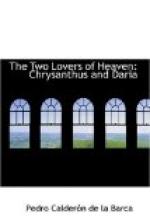Play, General. Stage directions following lines of spoken text are typically right justified in the printed source. In this electronic edition they simply follow the line of spoken text.
Play, General. In a few places, Denis Florence MacCarthy’s (1817-1882) translation as published differs noticeably from a Spanish (or more properly, Castillano) text of the drama, published after this translation, available to this transcriber. I do not have access to the Spanish edition that Mr. MacCarthy used as the basis of his translation, so perhaps a better preserved version of Pedro Calderon de la Barca’s (1600-1681) drama was discovered. Or perhaps Mr. MacCarthy used some poetic license in editing the drama. Some differences may be due to printer’s errors. Whatever the reason, I have noted below these differences so that a reader comparing this e-book to a Spanish edition will not be confused about these omission, and think them caused by a transcription error of mine, or pages missing from the printed source.
Act 1, Scene 2. Ovid’s ‘Remedy of Love’ is referred to three times, but as ‘Remedies of Love’ on the third occasion. A Spanish text has “Remedio” the first time, and “Remedios” elsewhere. I have found references to the work as both ‘Remedium Amoris’ and ‘Remedia Amoris.’
Act 1, Scene 2. There is an apparent discrepancy in the play. Chloris is clearly present in the grove, and in “Persons” is listed as one of four priestesses of Diana, yet the lines “We three share;—’t is thy delight” and “For here three objects we behold” imply she is not part of the group of priestesses. There is no stage direction [such as: (Chloris sits behind a tree.] in the printed source, nor in a Spanish text of the play, to explain this. Perhaps (as may be guessed from the line “From their tender years go thither” in the previous scene) the character is an acolyte or novice priestess played by a child. She only appears in this scene.
Act 1, Scene 2. “My blessings on your choice and you! / . . . Are nothing to a pretty face.” A Spanish text gives Escarpin seventeen lines here, rather than five. The last dozen lines contain a story of a clever vixen and a comely partridge.
Act 1, Scene 3. The line “Yes, God and Man is Christ” is not indented in the printed source, but logically should be, and is in a Spanish text of the play. I have indented it above.
Act 1, Scene 3. The line “Why delay? Arrest them.” in the printed source is shown as two lines ("Why delay? / Arrest them."), but this seems to be a printer’s error as it breaks the asonante verse pattern.
Act 1, Scene 3. In order to preserve the verse, I have indented the line “Why, why, O heavens!”
Act 2, Scene 1. I have indented the line “What then?”
Act 2, Scene 1. With the line “Clemency in fine had won,” there is another apparent discrepancy in the play. Polemius is angry at Chrysanthus when the soldiers return in Act 1, Scene 3.




